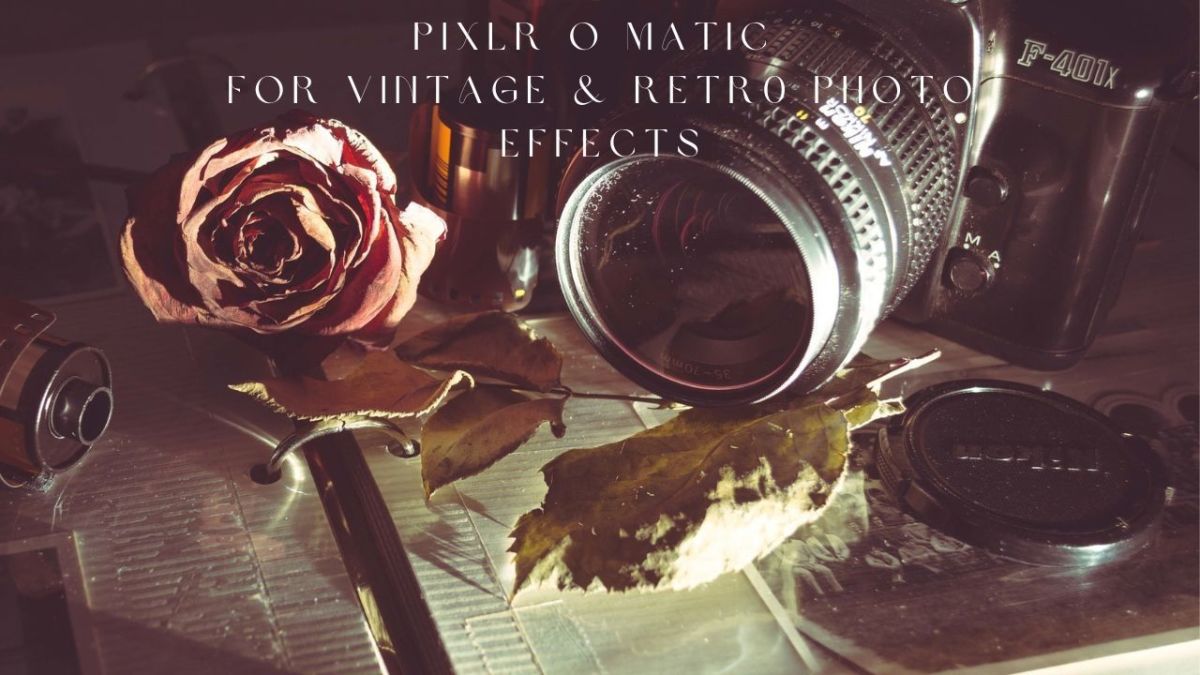Street Photography and the Story
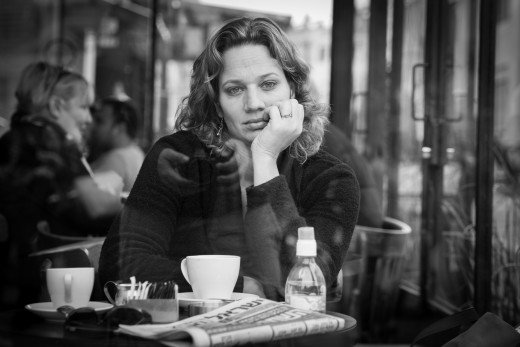
Street photography is photography that features the human condition within public places. Street photography does not necessitate the presence of a street or even the urban environment. Though people usually feature directly, street photography might be absent of people and can be an object or environment where the image projects a decidedly human character in facsimile or aesthetic value. Wikipedia
Street photography is alive and well with many professionals dedicating their talents to capturing telling images of what their city life is, what it is not and everything in between.
However the best street photos are usually the ones that feature subjects that when a viewer sees the image feel like there is a story behind them.
This is what causes viewers to pay attention to the image and stay long enough looking at them that it creates a feeling which in turn makes your name as a photographer stand out.
You need to stand out for your work because if you don't you are just simply one more photographer among the crowd.
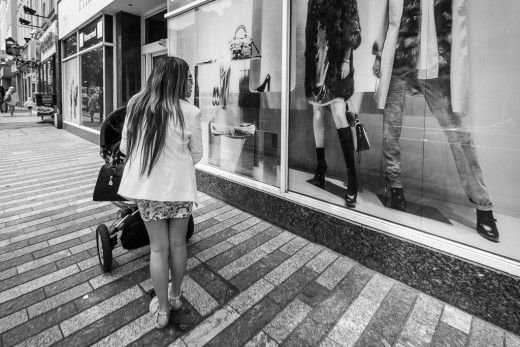
As a well known street photographer puts it "In particular, the way in which the observer can create (or be led to create) a narrative around an image, even when one may not exist. Or as Jack puts it, "I'm attracted to moments that are humorous and strange or surreal. And ideally I like to find scenes that capture the essence of an imagined story". Jack Simon
I enjoy the hunt for that moment of mystery, surprise, and humor in my everyday life. I seek unplanned and unposed images that hint to a larger story, like a publicity still from some forgotten movie. These fragments of fictional stories are drawn from the real world in an odd coupling of my unconscious, my intentions, and chance. -Jack Simon
You are probably thinking that almost any images taken that shows people has a story behind it.
This is probably true but to make your images that much more powerful in retaining a viewer's gaze, they need to feature something that can be considered a storyline. Look at the previous images and the one following this capsule.
What is the lady thinking about while sitting alone with her coffee cup? Is she waiting for someone? Is she happy or sad, is she married,single and so on.
Did you notice that there are two coffee cups and that you can almost see the photographer's reflection on the window. Is she amused by his taking her image?
The lady with the child carriage, is she thinking that the dresses are nice or is she not convinced they fit her style, or maybe she thinks that they are too expensive, where is this place?
The photo of the balloon street performer or vendor as she attentively listens to the man . What is he saying, is he scolding her or complaining about her being there?
The fourth image of the gentleman about to eat what looks to be a sandwich. Is he on his lunch break, does he like his lunch or maybe is he homeless? What kind of work does he do. Look at what he is wearing.
All these elements in every picture can tell a lot about a subject and it is this fact that makes these photos interesting to begin with.
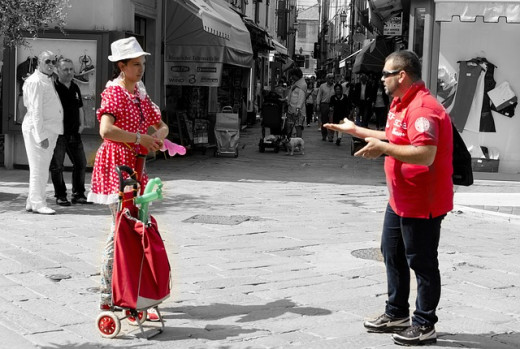
Like this particular approach to street photography?
One of the most important aspects of storytelling with your images is that you need to pay attention to your composition.
You need to isolate (up to a point) your subject or subjects.
If you do not and include too many elements then the intention of creating an avenue for the mind to fill in the blanks with all sorts of questions about what the subject is doing becomes lost and the viewer won't be able to easily figure out what the subject is doing and why.
The mind gets confused by all of the visuals and will probably wander of and instead of retaining the image it will discard it.
I mentioned in the parenthesis up to a point because if you get too close to the subject whether physically or by a zoom lens then you have isolated it to the point that there is no story to tell because the viewer has no base of reference.
You need to include other elements to at least let it be known (or assumed) where the subject is and more or less what the subject is doing.
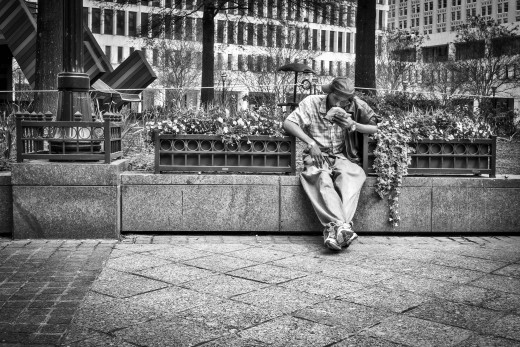
Use Your creativity when composing your images and if need be look at the works of some of the best street photographers. You can get plenty of ideas in how to compose and what to look for.
The key is to look at a scene, think about what a viewer would think and compose the shoot around that. In other words put yourself in the place of a viewer of the image keeping in mind that the person looking at it was not there.
Your image needs to tell a story by itself without the live action benefit that you had when you took it.
Do not copy their work but try to emulate their style. As you grow in your technique and as your experience develops you can start to formulate your own way of doing things and slowly start to build your portfolio.
Keep in mind that these types of images are very useful in creating eBooks or print ones and many photo related publications can use them as well.
If you can try to get at least one well known book about street photography techniques and study how the images are composed but most importantly , how the images were used.
One such work and one of my favorites is "Humans of New York" by Brandon Stanton and currently a number one seller.
On October 15, 2013, the Humans of New York book, which is based on the eponymous photography blog, was released. Published by St. Martin's Press, the book sold 30,000 copies as pre-orders. Ahead of the release he was also interviewed by with Bill Weir, for ABC News's Nightline news story titled, "'Humans of New York': Photog Gone Viral".
As of January 20, 2015, the book had been on the New York Times Bestseller list for 28 weeks; it reached the number 1 position on The New York Times Non-Fiction Best Sellers of 2013 on the week of November 3, 2013, and again on the week of December 21, 2014. Wikipedia
It took Stanton a while to complete (it features over 6,000 images) but it is full of interesting images, mostly of people, thus "Humans" in the title and each image tells a story.
Worthwhile to have in your collection if you are able. Study it and learn from it as well as other works from other talented pros.
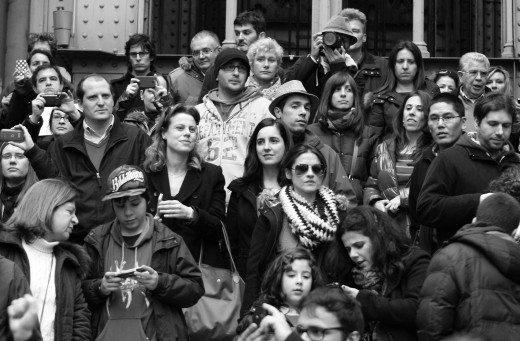
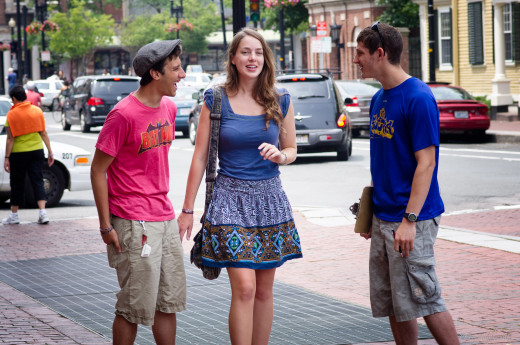
- Telling Stories With Photos - Digital Photography School
There are many reasons that I love photography, not the least of which is that a photograph (or a series of them) has the ability to convey stories to those that view them. Over the centuries people have gathered around campfires, in town squares, o

© 2015 Luis E Gonzalez









